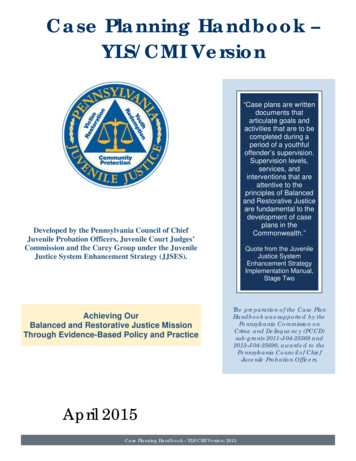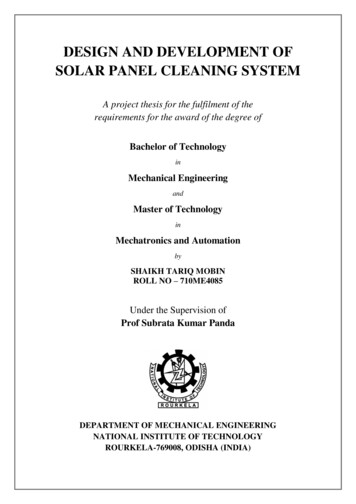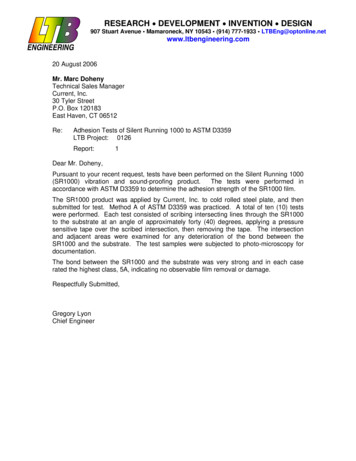
Transcription
Vol-1 Issue-5 2015IJARIIE-ISSN(O)-2395-4396DESIGN AND DEVELOPMENT OF CMISOFTWARE (CMIS) IN TEACHING ANDLEARNING COMMUNICATIONS ANDNETWORKSJosephine R. Bayonito11Associate Professor, College of Information and Communications TechnologyBulacan State University, City of Malolos, Bulacan, PhilippinesABSTRACTThe study focused in the development of computer-managed instruction software to aid teaching and learningCommunications and Networks for the teachers and students of the Bulacan State University. The CAI DesignModel (CDM) was utilized in the study. Four major phases were implemented consisting of (1) analysis orassessment phase, (2) designing phase, (3) development/formative phase, and (4) evaluation and revision phase.Some of the important features that are included in the software are: (1) motivation towards learning, (2) retentionof knowledge, (3) systematic record-banking, (4) individualization of learning pace, (5) integrity of subject mattercontent, (6) self-direction, (7) immediate response, (8) flexibility, and (9) access control. The topics included in thesoftware were solely based from the course syllabus prescribed by the Commission on Higher Education. Theacceptability of the software was determined using five dimensions: (1) subject matter content, (2) readability, (3)usability, (4) instructional design and (5) portability. Considering the important features of the software, CMIS isrecommended as an instructional aid and reference material for students taking up the course.Keyword: CAI design model, computer-aided instruction, computer-managed instruction, communications andnetworks, instructional software development, teaching and learning using technology1. INTRODUCTIONRecent technological advances have created the possibility for newer ways of learning and teaching. Theeducation reform is one of the important issues we are confronting today. One of the applications of informationtechnologies is the modern education based on computer and network technology. This application will not onlybring the innovation of education method, but also result in the fundamental innovation of education thoughts,conception, theory of teaching and learning, and even the whole education system. And the modern educationtechnology is the breakthrough point of the education reform (Liu and Wang, 1999). The pace of both technologicaldevelopment and the introduction of new technologies into educational settings have dramatically accelerated duringthe past decade. The combinations of computation, connectivity, visual and multimedia capacities, miniaturizationand speed have radically changed the potential for technologies in schooling. These developments are now makingit possible for technologies to be designed and deployed to produce powerful and kinked technologies that cansubstantially address some of the core problems of education. Among these educational technologies, ComputerAssisted Instruction (CAI), Computer-Aided Instruction (CAI), Computer-Managed Instruction (CMI), Electronicbased Instruction (EBI), Computer-based Learning (CBL), Computer-based Teaching (CBT), Internet-basedInstruction (IBI) and Web-based instruction (WBI), collectively known as Computer-based Education (CBE) isconsidered to have the highest potential of raising the effectiveness of teaching and learning. Computer-based1409www.ijariie.com127
Vol-1 Issue-5 2015IJARIIE-ISSN(O)-2395-4396education, diverse and rapidly expanding spectrum of computer technologies assist the teaching and learningprocess. Computer-assisted (or aided) Instruction is an interactive instructional technique whereby a computer isused to present the instructional material, direct the user to additional material which meets the needs of the leanerand monitor or track learning that takes place. CAI tools, such as word processors, spreadsheets, and databases,collect, organize, analyze, and transmit information. They also facilitate communication among students, betweenstudents and instructors, and beyond the classroom to distant students, instructors, and experts. It is also used todescribe Internet-based instruction through use of web pages, bulletin boards, listservs and newsgroups, video andreal audio, graphics and hands-on application.Being one of the premier and leading universities in Central Luzon and entire the country, Bulacan StateUniversity (BulSU) aspires to improve the quality of life of people and promote socio-economic development. Theuniversity commits itself to develop graduates capable of responding to the needs of the region and the demands ofthe global standards. It aims to pursue excellence in its programs through higher professional, technical and specialinstructions. BulSU ensures the attainment of empowered and globally competitive graduates through; promotion ofquality and relevant educational programs responsive to meet international standards, generation and disseminationof knowledge in the broad range of disciplines relevant and responsive to the dynamically changing domestic andinternational environment, broadening of the access of deserving students to educational opportunities andoptimizing the social, institutional and individual returns and benefits derived from the utilization of highereducation resources. As one of the key institutions of the university, the College of Information andCommunications Technology (CICT) would like to contribute to the attainment of the goals of BulSU. The collegeprimarily provides instructions, trainings and learning experiences in the different fields of computer educationwhich demands new skills and better system from a broad spectrum of disciplines and interests where integrity,competence, quality work, professionalism, work values and self-confidence are distinctively sculpted by the strictmeaningful pursuit of high ideals for a more interconnected world through networking with a deep commitment to abroader common good. CICT envisions itself to be a center of excellence in information and communicationtechnologies (ICTs). It aims to produce high level of expertise, excellent and competent individuals capable ofbringing our country to a bright future and nurtures them towards becoming responsible individuals with a sense ofself-fulfillment. The college aims to realize this vision through contributing to the national development throughresearch and technology, producing competent graduates equipped with greater knowledge and skills in theapplication of information technology (IT), and keeping abreast with the changes and advancement in informationand communication technology.Thus, the researcher would like to present computer-managed instruction software (CMIS) in teaching andlearning Communications and Networks. The college is primarily catering computer education and the subject is theshowcase of communication technologies. Hence, the development of this software as a supplement to traditionaleducation system exhibits the use of modern advancement in ICT. The researcher, as an educator, would like to takepart in the realization of the university goals and present the software to the IT students for them to be able to graspwith the rapid changes in the world’s education system.1.1 Significance of the StudyThe development of the computer-managed instruction software is expected to play a vital role in computereducation, specifically in the subject Communications and Networks. The output of this study aims to aid facultymembers of the CICT and the students of Bulacan State University. This study can ease teachers from traditionaltasks associated with teaching, allowing them to have more time to attend to the individual needs of the learners.The development of the software can also assist teachers in implementing any or all the four essential phases ofinstruction; (1) presenting information, (2) guiding the student, (3) proving student practice and (4) assessing studentlearning. Today, teachers are utilizing computers in their classrooms more than the basic productivity tools of wordprocessors, spreadsheets and databases. A new breed of software, instructional courseware, may be exactly a tool tospark students’ interest to learn subjects like Communications and Networks. CMIS can provide greater teaching1409www.ijariie.com128
Vol-1 Issue-5 2015IJARIIE-ISSN(O)-2395-4396and learning effectiveness through its audio-visual effects. Difficult concepts will be made easier to understand. Itwill transform complicated lessons in an easy-to-understand presentation and an entertaining approach. The softwareaims to deliver effective English-language based training to students. CMIS can dramatically increase students’access to information. The software can adopt the capabilities and preferences of the individual student and increasethe amount of personalized instruction a student receives. Many students can be benefited from the immediateresponsiveness of the computer interactions and appreciate the self-paced and private learning environment.Moreover, computer-learning experiences can engage the interest of students, motivating them to learn andincreasing independence and personal responsibility for education. It can also be used by students for private studyon individual PCs following the instruction-taught lesson. It can also serve as additional reference material forstudents from other colleges taking up Communications and Networks. It can increase the cost-effectiveness of theinstructional staff by reducing the classroom teaching content of the course resulting to potentially increase theprofitability of the institution. The development and acceptability of the CMIS is expected to be a substantialcontribution to the field of educational research. We have to admit that the university world is in a state of change,shifting from traditional system to a more advance approach integrating technologies to attain a better education.The result of this study can also serve as a reference for other researches and development for the advancement ofthe world’s education system.1.2 Theoretical FrameworkThe use of information technology to support teaching, training, learning, entertainment and education ingeneral emerged several decades ago. Many claims about the relative value of the educational software have beenmade. Although it has been difficult to prove the advantages of educational software over conventional teaching,training and learning, its use has increased anyway and many attempts have been made to develop instructionalsoftware products for different subjects, in a wide variety of educational settings and of course different targetgroups. The development of the CMIS is theoretically based in the Instructional Design theory. This theory is thestudy of how to best design instruction so that learning will take place. It differs from the Learning theory which isthe study of how people learn. Basically, the Instructional Design theory is drawn from the Learning theory.Instructional design according to Briggs, Gustafson and Tillman (1991), ensures congruence between objectives,instruction and evaluation. They identified six principles of this theory; (1) objectives, instruction and evaluationare related and congruent and each affects other, (2) components must be related, (3) process of instructional designmust be systematic but flexible to allow changes and cyclical development, (4) instructional design should beresearch-based, (5) must be open to testing and improvement, and (6) compare final design to an alternative or atleast to the objectives- “Does it work?”. The two broad fields of the instructional design theory are directedinstruction (instructional system) and constructivism. The directed or the instructional systematic design implies theconsiderations for the needs of the learners, activities which help in the achievements of the goals, the instructionalmedia, assessment tools, and revisions. Constructivism, on the other hand, is the outgrowth of the earlier theoriessuch as discovery learning. This approach makes learning more relevant to students by embedding it in realsituations. Emphasis is on the process learning rather than searching for the answer. In the classroom settings,instructional adjustments are easily and naturally implemented, an informal lecture can be instantly changed intogroup discussion without prior planning. There are times that there is no plan for the lessons which should be takenup. With the use of the modern technology incorporated with the constructivism theory, it properly provided thetypes of learning and modes of interaction that will achieve the subject goals. Basically, the approach should followan analysis of the learning goals, learner needs, budget time frame, access to technology, advantages of particulartechnologies, limitations and constraints. The theoretical foundation of creating best design instruction to enhancelearning is adopted in the construction of the computer-managed instruction software.1.3 Conceptual FrameworkThe paradigm shown in Figure 1 is implemented in the construction and development of the computermanaged instruction software. Context, Input, Process and Output (CIPO) Model is adopted in designing thesoftware. This model outlined the significant framework and each part plays vital role. The context within which1409www.ijariie.com129
Vol-1 Issue-5 2015IJARIIE-ISSN(O)-2395-4396the CMIS was designed primarily consisted of the educational philosophy of the Bulacan State University and thevision, mission, goals and objectives of the CICT specifically, as mentioned in the introduction of this study. Thenecessary inputs are driven from syllabus and course outline, textbooks, references, video clippings related to thetopics, web-based materials, programming tools, video and graphics editing tools, sound recorder/editor andcomputer hardware, including peripheral devices. The textbooks are used as the sources of the contents in thediscussions. Other reference materials such as web-based information, video clippings and other related sourceswere also used. The process was properly documented which includes all the steps from planning, the developmentproper and the assessment of the instructional software. The development process of the CMIS utilized the CAIdesign model (CDM). Four significant phases composes the adopted design model; (1) assessment or analysis, (2)design, (3) development and formative and (4) evaluation and revision.Finally, the fourth phase in the model, the output, comes up with the computer-managed instructionsoftware in teaching and learning Communications and Networks.1.4 Statement of the ProblemThe major purpose of this study is to develop computer-managed instruction software in teaching andlearning Communications and Networks.Specifically, the study sought to answer the following questions:1. What are important features of Computer- Managed Instruction Software?2. What are the considerations and limitations of Computer- Managed Instruction Software?3. What design models may be used in the development of Computer- Managed Instruction Software?4. How acceptable is Computer- Managed Instruction Software in terms (a) Subject matter content, (b)Readability, (c) Usability, (d) Instructional design and (e) Portability?1.5 Scope and DelimitationsThe study focused on the development of the computer-managed instruction software. This aimed toproduce an instructional material in teaching and learning Communications and Networks which integrates the1409www.ijariie.com130
Vol-1 Issue-5 2015IJARIIE-ISSN(O)-2395-4396advancement of our technology in the field of education. It is designed for students of the Bulacan State Universityin learning Communications and Networks. The content of the software was solely based from the currentprescribed syllabus of the course provided by the Higher Education Department. Networking practices and actualinstallations are not included in the scope of CMIS. The development process made use of the programming toolDelphi. Other software used are Text editor, Adobe Photoshop, MS Word, Notepad, Sound recorder, MS Access,Macromedia Flash and MS Paint. Evaluation is given at the end of each lesson. Random questions are provided.The learner will be able to continue to the next lesson if he has passed the examination presented on the previouslesson. The learner must be able to answer at least fifty percent (75%) of the total quiz items. Immediate feedbackis given for wrong answer but does not identify the correct answer. The ultimate purpose of immediate feedback isto correct wrong thinking by allowing them to review the topics. To test the acceptability of the software, theresearcher asked three adept people to use the software and assess according to the specified criteria. The researcherchosen (1) a faculty who has finished her MSIT degree at the Hannam University in Korea and an expert in teachingand developing multimedia applications, (2) an expert in computer-based education (CBE) holding the degrees inPHD, MSIT and MAE major in CAI, and (3) a professional software developer from the Management InformationSystem Department, to test the software and determine the acceptability. Three 3rd year BSIT students were alsorandomly selected to use the software during the dry run implementation. The software was designed and developedto aid and supplement traditional teaching techniques and not to totally replace the role of the teacher.II. RESEARCH METHODSThe study is descriptive in nature. Thus, its concern is the construction of a tangible contribution for theimprovement in the technology of our education system. The study primarily focused on the process ofimplementing procedures for the development of instructional software. It involves all the vital procedural stepsfrom the formulation of the objectives, selection of the design model of the study, identification of the targetclientele and the available sources of data, selection and development of the data collected, and of course, theevaluation and revision of the output. Descriptive method of research allows researchers to understand situation andnecessities more fully and develop more worthwhile and useful studies. It usually involves observation anddescription of variables as they are distributed to the population (Crowl, 1993). Quality observation is at the heart ofthe descriptive research (Heppner et. Al, 1992). The study also made use of another technique known as theResearch and Development method (R&D). This method is seen to be a very effective vehicle in the advancementof the education technology. The main essence of the method involves the development and validation of theinstructional and educational materials. The R & D technique is designed to (1) examine the findings of the pastresearches, (2) innovate and develop the material based on new findings, (3) test the innovation, and (4) revise thematerial. In examining the findings of the past researches, this study analyzed the content of the documentarymaterials that already exist and is available as sources. This technique is referred to as documentary analysis.III. FINDINGS OF THE STUDY3.1 Problem #1: Important Features of the Computer-Managed Instruction SoftwareThe computer-managed instruction software has several important features; (1) motivation towardslearning, (2) retention of Knowledge, (3) systematic record-banking, (4) individualization of learning pace, (5)integrity of subject matter content, (6) self-direction, (7) immediate response, (8) flexibility, and (9) access control.Motivation towards learning. Motivation is the primary factor in instructional models. Reiber describesfive principles for computer-based education derived from constructivism and the first is to provide a meaningfullearning context that supports intrinsically motivating and self-regulated learning. Motivation dimension rangesfrom extrinsic, outside the learning environment to intrinsic, integral to the learning enviro
software were solely based from the course syllabus prescribed by the Commission on Higher Education. The acceptability of the software was determined using five dimensions: (1) subject matter content, (2) readability, (3) usability, (4) instructional design and (5) portability. Considering the important features of the software, CMIS isAuthor: Josephine R. Bayonito











